英语介词知识点归纳
- 格式:docx
- 大小:14.19 KB
- 文档页数:4
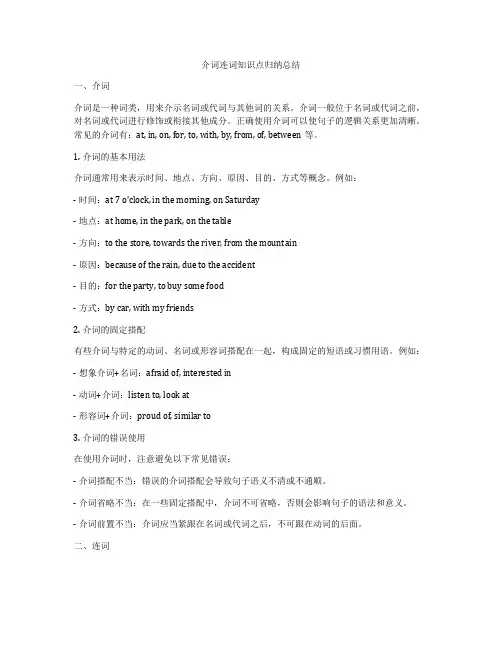
介词连词知识点归纳总结一、介词介词是一种词类,用来介示名词或代词与其他词的关系。
介词一般位于名词或代词之前,对名词或代词进行修饰或衔接其他成分。
正确使用介词可以使句子的逻辑关系更加清晰。
常见的介词有:at, in, on, for, to, with, by, from, of, between等。
1. 介词的基本用法介词通常用来表示时间、地点、方向、原因、目的、方式等概念。
例如:- 时间:at 7 o'clock, in the morning, on Saturday- 地点:at home, in the park, on the table- 方向:to the store, towards the river, from the mountain- 原因:because of the rain, due to the accident- 目的:for the party, to buy some food- 方式:by car, with my friends2. 介词的固定搭配有些介词与特定的动词、名词或形容词搭配在一起,构成固定的短语或习惯用语。
例如:- 想象介词+名词:afraid of, interested in- 动词+介词:listen to, look at- 形容词+介词:proud of, similar to3. 介词的错误使用在使用介词时,注意避免以下常见错误:- 介词搭配不当:错误的介词搭配会导致句子语义不清或不通顺。
- 介词省略不当:在一些固定搭配中,介词不可省略,否则会影响句子的语法和意义。
- 介词前置不当:介词应当紧跟在名词或代词之后,不可跟在动词的后面。
二、连词连词是一种词类,用来连接句子的不同部分,使句子结构更加清晰和连贯。
连词可以连接并列成分,引导从句,表达因果关系等。
常见的连词有:and, but, or, for, yet, so, because, although, while, as等。
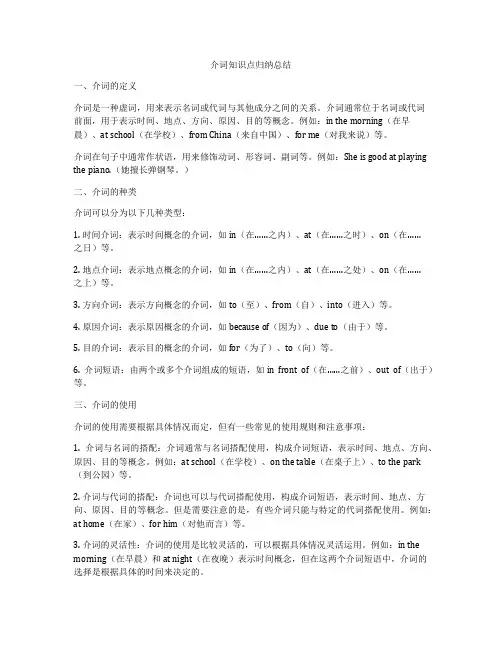
介词知识点归纳总结一、介词的定义介词是一种虚词,用来表示名词或代词与其他成分之间的关系。
介词通常位于名词或代词前面,用于表示时间、地点、方向、原因、目的等概念。
例如:in the morning(在早晨)、at school(在学校)、from China(来自中国)、for me(对我来说)等。
介词在句子中通常作状语,用来修饰动词、形容词、副词等。
例如:She is good at playing the piano.(她擅长弹钢琴。
)二、介词的种类介词可以分为以下几种类型:1. 时间介词:表示时间概念的介词,如in(在……之内)、at(在……之时)、on(在……之日)等。
2. 地点介词:表示地点概念的介词,如in(在……之内)、at(在……之处)、on(在……之上)等。
3. 方向介词:表示方向概念的介词,如to(至)、from(自)、into(进入)等。
4. 原因介词:表示原因概念的介词,如because of(因为)、due to(由于)等。
5. 目的介词:表示目的概念的介词,如for(为了)、to(向)等。
6. 介词短语:由两个或多个介词组成的短语,如in front of(在……之前)、out of(出于)等。
三、介词的使用介词的使用需要根据具体情况而定,但有一些常见的使用规则和注意事项:1. 介词与名词的搭配:介词通常与名词搭配使用,构成介词短语,表示时间、地点、方向、原因、目的等概念。
例如:at school(在学校)、on the table(在桌子上)、to the park (到公园)等。
2. 介词与代词的搭配:介词也可以与代词搭配使用,构成介词短语,表示时间、地点、方向、原因、目的等概念。
但是需要注意的是,有些介词只能与特定的代词搭配使用。
例如:at home(在家)、for him(对他而言)等。
3. 介词的灵活性:介词的使用是比较灵活的,可以根据具体情况灵活运用。
例如:in the morning(在早晨)和at night(在夜晚)表示时间概念,但在这两个介词短语中,介词的选择是根据具体的时间来决定的。
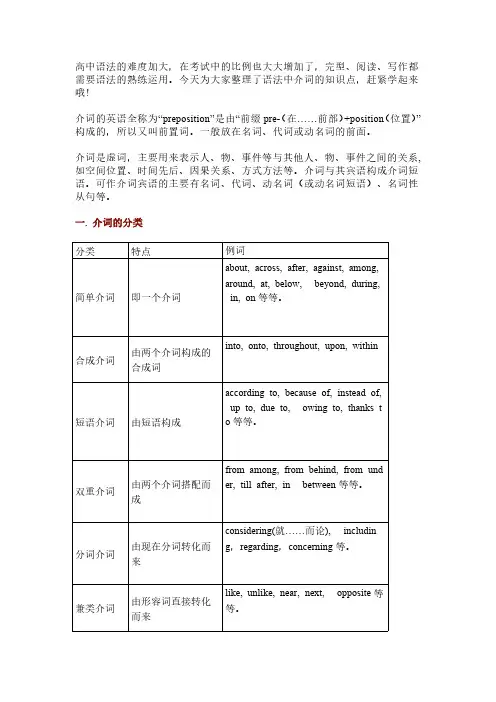
高中语法的难度加大,在考试中的比例也大大增加了,完型、阅读、写作都需要语法的熟练运用。
今天为大家整理了语法中介词的知识点,赶紧学起来哦!介词的英语全称为“preposition”是由“前缀pre-(在……前部)+position(位置)”构成的,所以又叫前置词。
一般放在名词、代词或动名词的前面。
介词是虚词,主要用来表示人、物、事件等与其他人、物、事件之间的关系,如空间位置、时间先后、因果关系、方式方法等。
介词与其宾语构成介词短语。
可作介词宾语的主要有名词、代词、动名词(或动名词短语)、名词性从句等。
一.介词的分类分类特点例词简单介词即一个介词about,across,after,against,among, around,at,below,beyond,during, in,on等等。
合成介词由两个介词构成的合成词into,onto,throughout,upon,within短语介词由短语构成according to,because of,instead of, up to,due to,owing to,thanks t o等等。
双重介词由两个介词搭配而成from among,from behind,from under,till after,in between等等。
分词介词由现在分词转化而来considering(就……而论),including,regarding,concerning等。
兼类介词由形容词直接转化而来like,unlike,near,next,opposite等等。
二.介词短语的语法功能介词不能独立在句中做成份,介词后必须与名词、代词、或动名词构成介词短语在句中充当一个成分,表示人、物、事件等与其它人、物、事件等之间的关系。
介词短语的功能例句作定语They didn’t find the solution to the problem.作状语We have breakfast at seven.(表时间)They were late for the meeting because of the heavy rai n.(表原因)What do you mean by doing such a thing?(表方法)Nothing in the world could live without air or water.(表条件)作表语When I paid a visit to you yesterday,you were not at h ome.作宾语补足语I found the old building in a bad condition.三.表示相同或相似概念的介词(短语)的区别表示的概念介词(短语)区别例子时间inonatat在一个时间点上;in在一段时间之内;on在具体某一天或具体的上午、下午、晚上。
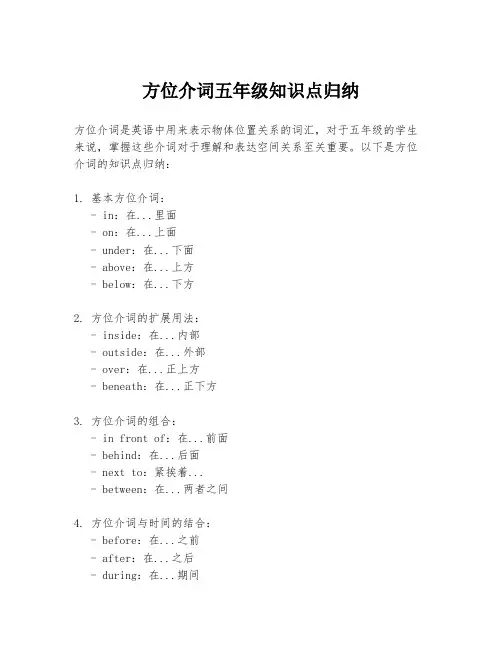
方位介词五年级知识点归纳方位介词是英语中用来表示物体位置关系的词汇,对于五年级的学生来说,掌握这些介词对于理解和表达空间关系至关重要。
以下是方位介词的知识点归纳:1. 基本方位介词:- in:在...里面- on:在...上面- under:在...下面- above:在...上方- below:在...下方2. 方位介词的扩展用法:- inside:在...内部- outside:在...外部- over:在...正上方- beneath:在...正下方3. 方位介词的组合:- in front of:在...前面- behind:在...后面- next to:紧挨着...- between:在...两者之间4. 方位介词与时间的结合:- before:在...之前- after:在...之后- during:在...期间5. 方位介词的比较级和最高级:- higher:更高的- highest:最高的- lower:更低的- lowest:最低的6. 方位介词的反义词:- inside的反义词是outside- above的反义词是below- in front of的反义词是behind7. 方位介词的语境应用:- 描述房间布局:The desk is in front of the window.- 描述物体位置:The cat is under the table.- 描述时间点:We will arrive before the meeting starts.8. 方位介词的练习:- 练习题:The book is not on the table, it is under the table.- 填空题:Please put the vase above the shelf.9. 方位介词的易混淆点:- on和over的区别:on表示接触表面,over表示上方但不接触。
- in和inside的区别:in通常用于表示在某个空间内,inside强调在内部。
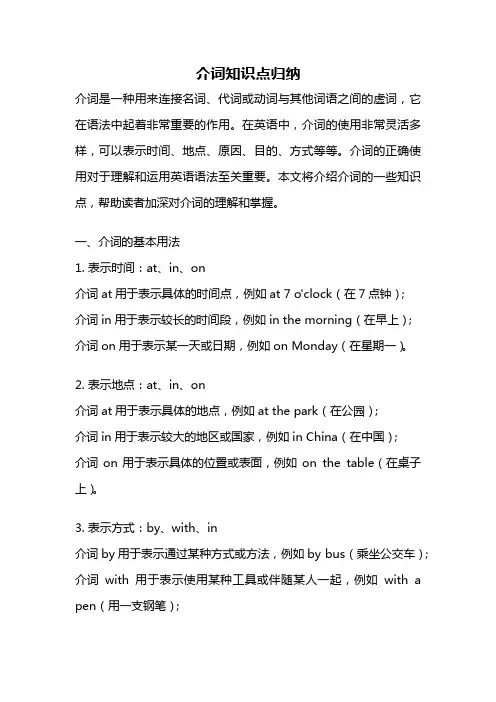
介词知识点归纳介词是一种用来连接名词、代词或动词与其他词语之间的虚词,它在语法中起着非常重要的作用。
在英语中,介词的使用非常灵活多样,可以表示时间、地点、原因、目的、方式等等。
介词的正确使用对于理解和运用英语语法至关重要。
本文将介绍介词的一些知识点,帮助读者加深对介词的理解和掌握。
一、介词的基本用法1. 表示时间:at、in、on介词at用于表示具体的时间点,例如at 7 o'clock(在7点钟);介词in用于表示较长的时间段,例如in the morning(在早上);介词on用于表示某一天或日期,例如on Monday(在星期一)。
2. 表示地点:at、in、on介词at用于表示具体的地点,例如at the park(在公园);介词in用于表示较大的地区或国家,例如in China(在中国);介词on用于表示具体的位置或表面,例如on the table(在桌子上)。
3. 表示方式:by、with、in介词by用于表示通过某种方式或方法,例如by bus(乘坐公交车);介词with用于表示使用某种工具或伴随某人一起,例如with a pen(用一支钢笔);介词in用于表示在某种状态或情况下,例如in a hurry(匆忙中)。
二、常见介词的搭配1. atat the cinema(在电影院)at the party(在派对上)at home(在家)at work(在工作)2. inin the car(在车里)in the city(在城市)in the morning(在早上)in summer(在夏天)3. onon the bus(在公交车上)on the street(在街上)on the weekend(在周末)on a sunny day(在一个阳光明媚的日子)三、常用介词短语1. in front of(在...前面)The cat is sitting in front of the door.(猫坐在门前。
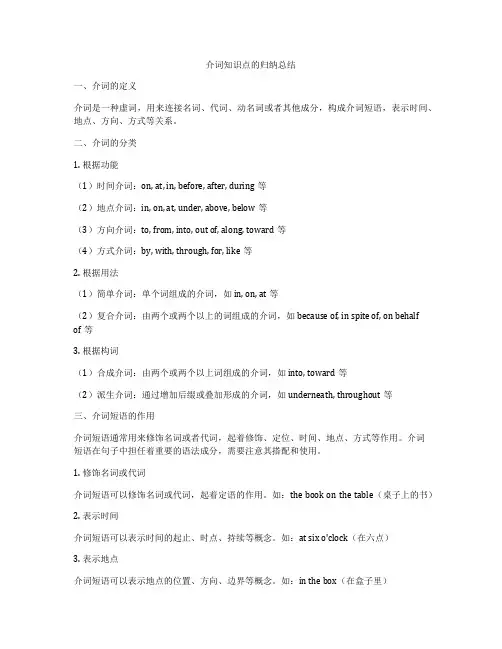
介词知识点的归纳总结一、介词的定义介词是一种虚词,用来连接名词、代词、动名词或者其他成分,构成介词短语,表示时间、地点、方向、方式等关系。
二、介词的分类1. 根据功能(1)时间介词:on, at, in, before, after, during等(2)地点介词:in, on, at, under, above, below等(3)方向介词:to, from, into, out of, along, toward等(4)方式介词:by, with, through, for, like等2. 根据用法(1)简单介词:单个词组成的介词,如in, on, at等(2)复合介词:由两个或两个以上的词组成的介词,如because of, in spite of, on behalfof等3. 根据构词(1)合成介词:由两个或两个以上词组成的介词,如into, toward等(2)派生介词:通过增加后缀或叠加形成的介词,如underneath, throughout等三、介词短语的作用介词短语通常用来修饰名词或者代词,起着修饰、定位、时间、地点、方式等作用。
介词短语在句子中担任着重要的语法成分,需要注意其搭配和使用。
1. 修饰名词或代词介词短语可以修饰名词或代词,起着定语的作用。
如:the book on the table(桌子上的书)2. 表示时间介词短语可以表示时间的起止、时点、持续等概念。
如:at six o'clock(在六点)3. 表示地点介词短语可以表示地点的位置、方向、边界等概念。
如:in the box(在盒子里)4. 表示方式介词短语可以表示动作的方式、手段、原因等。
如:by train(乘火车)四、介词的用法注意事项1. 介词的搭配介词的搭配非常重要,不同的介词搭配可以表达不同的意义。
比如:at school, in the school, on the school都表示不同的含义。
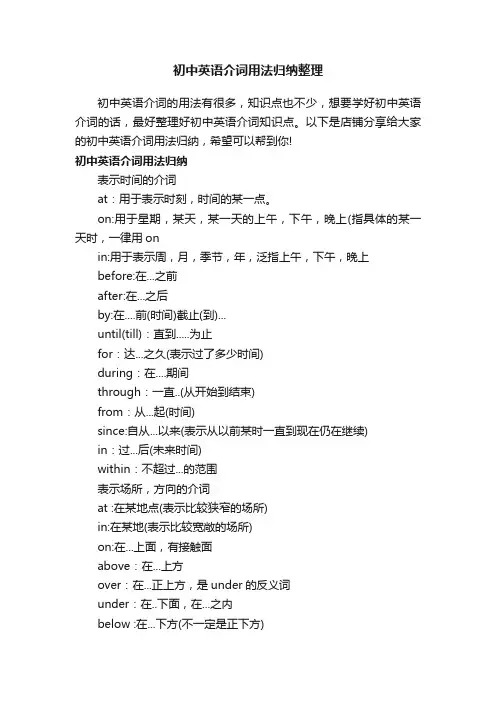
初中英语介词用法归纳整理初中英语介词的用法有很多,知识点也不少,想要学好初中英语介词的话,最好整理好初中英语介词知识点。
以下是店铺分享给大家的初中英语介词用法归纳,希望可以帮到你!初中英语介词用法归纳表示时间的介词at:用于表示时刻,时间的某一点。
on:用于星期,某天,某一天的上午,下午,晚上(指具体的某一天时,一律用onin:用于表示周,月,季节,年,泛指上午,下午,晚上before:在...之前after:在...之后by:在....前(时间)截止(到)...until(till):直到.....为止for:达...之久(表示过了多少时间)during:在....期间through:一直..(从开始到结束)from:从...起(时间)since:自从...以来(表示从以前某时一直到现在仍在继续)in:过...后(未来时间)within:不超过...的范围表示场所,方向的介词at :在某地点(表示比较狭窄的场所)in:在某地(表示比较宽敞的场所)on:在...上面,有接触面above:在...上方over:在...正上方,是under的反义词under:在..下面,在...之内below :在...下方(不一定是正下方)near:近的,不远的by:在...的旁边,比near的距离要近between:在两者之间among:在三者或者更多的之中around:环绕,在...的周围,在....的四周in front of:在...的前面behind:在...后边in:在..之内,用于表示静止的位置into:进入out of :和into一样,也表示有一定的运动方向along:沿着across:横过(平面物体)through:贯通,通过to :达到..地点(目的地)或方向for:表示目的,为了.....from:从...地点起其他介词with:和..在一起; 具有,带有; 用某种工具或方法in:表示用什么材料(例如:墨水,铅笔等)或用什么语言。

英语介词知识点的归纳介词又叫前置词,一般放在名词的前面。
介词是一种虚词,一般不重读,不能在句中独立充当一个成分,它只是表示它后面的名词、代词或相当于名词的词、短语或从句与其它成分的关系。
下面小编给大家分享一些英语介词知识点,希望能够帮助大家,欢迎阅读!英语介词知识点1介词的分类介词可按其结构分为:1. 简单介词:简单介词是由一个单词构成的介词。
分为普通介词(如:at,by,for,in,over,to,up 等),合成介词(如:as for,onto,into,within,without,out of 等),和分词介词(如:concluding,regarding,concerning 等)三种。
2. 二重介词:二重介词是由两个简单介词重叠使用构成的。
如:from among,since before,until after,except in 等。
3. 短语介词:介词是由两个或者两个以上的词所组成的短语构成的。
一般说来,这个短语的最后一个词是简单介词。
如:according to,because of,instead of,in front of,with reference to 等。
介词还可按其词义分为下列几种:1. 表示地点。
如:about,across,after,among,around,behind,below,beside,beyond,down,from,into,off,over,throughout,towards,up,within,without 等。
2. 表示时间。
如:about,after,around,as,at,before,behind,between,by,during,for,from,in,into,of,on,over,past,since,through,till(until),to,towards,within 等。
3. 表示除去。
如:besides,but,except 等。
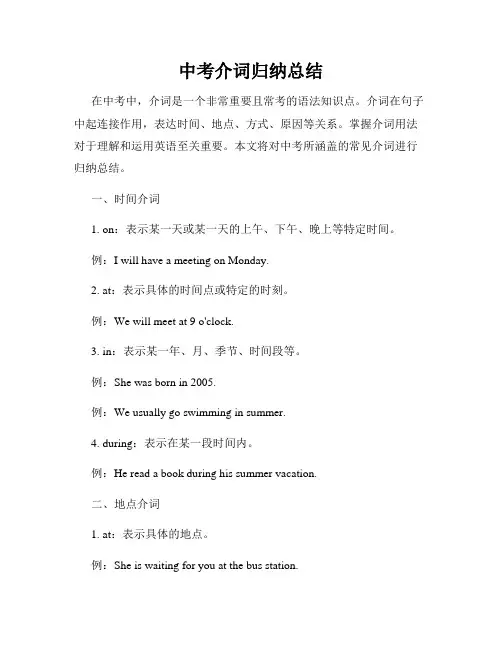
中考介词归纳总结在中考中,介词是一个非常重要且常考的语法知识点。
介词在句子中起连接作用,表达时间、地点、方式、原因等关系。
掌握介词用法对于理解和运用英语至关重要。
本文将对中考所涵盖的常见介词进行归纳总结。
一、时间介词1. on:表示某一天或某一天的上午、下午、晚上等特定时间。
例:I will have a meeting on Monday.2. at:表示具体的时间点或特定的时刻。
例:We will meet at 9 o'clock.3. in:表示某一年、月、季节、时间段等。
例:She was born in 2005.例:We usually go swimming in summer.4. during:表示在某一段时间内。
例:He read a book during his summer vacation.二、地点介词1. at:表示具体的地点。
例:She is waiting for you at the bus station.2. on:表示表面或某物之上。
例:There is a book on the table.3. in:表示在某个范围、区域、国家或大洲内。
例:We live in a small town.4. to:表示朝向、方向。
例:He went to the library.三、方式介词1. by:表示通过某种交通方式或手段。
例:I usually go to school by bus.2. with:表示伴随、陪同。
例:She walks to school with her friends.3. in:表示用某种方式或手段。
例:He communicated with her in English.四、原因介词1. for:表示目的、原因或理由。
例:He went to the store for some milk.2. because of:表示因为。

英语语法介词语法知识点_英语语法知识英语介词一般用于名词或者代词前面,表示该词与句中其他成分的关系。
介词可以分为时间介词、地点介词、方式介词、原因介词、数量介词和其他介词。
下面是小编为大家整理的关于英语语法介词语法知识点_英语语法知识,希望对您有所帮助。
欢迎大家阅读参考学习。
英语介词的定义介词是一种用来表示词与词, 或者词与句之间的关系的词,在句中不能单独作句成分。
介词一定要有宾语,充当宾语的一般有名词、代词或相当于名词的其它词、短语或句子,短语或从句。
英语介词的种类(1)简单介词,如at, in off, on, by, to, with等。
(2)合成介词,如into, inside, within, throughout等。
(3)短语介词,如according to, because of, in addition to, in front of, in spite of等。
(4)二重介词,如from behind, from among, until after, at about等。
英语常用介词用法与辨析一、表示方位的介词:in, to, on1. in 表示在某地范围之内。
如:Shanghai is/lies in the east of China. 上海在中国的东部。
2. to 表示在某地范围之外。
如:Japan is/lies to the east of China. 日本位于中国的东面。
3. on 表示与某地相邻或接壤。
如:Mongolia is/lies on the north of China. 蒙古国位于中国北边。
二、表示计量的介词:at, for, by1. at表示“以……速度”“以……价格”。
如:It flies at about 900 kilometers an hour. 它以每小时900公里的速度飞行。
I sold my car at a high price. 我以高价出售了我的汽车。
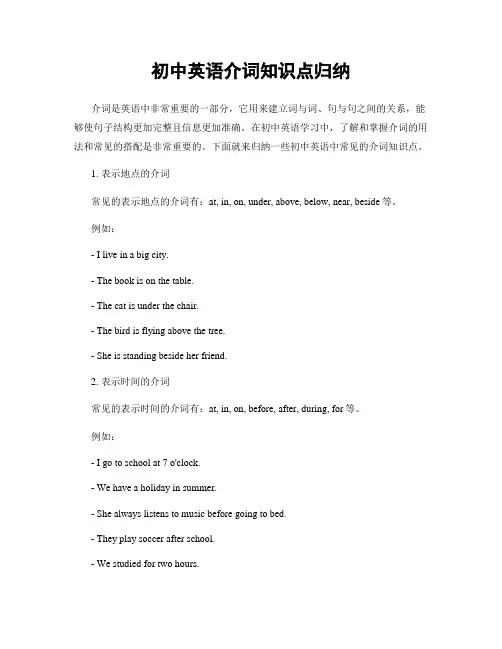
初中英语介词知识点归纳介词是英语中非常重要的一部分,它用来建立词与词、句与句之间的关系,能够使句子结构更加完整且信息更加准确。
在初中英语学习中,了解和掌握介词的用法和常见的搭配是非常重要的。
下面就来归纳一些初中英语中常见的介词知识点。
1. 表示地点的介词常见的表示地点的介词有:at, in, on, under, above, below, near, beside等。
例如:- I live in a big city.- The book is on the table.- The cat is under the chair.- The bird is flying above the tree.- She is standing beside her friend.2. 表示时间的介词常见的表示时间的介词有:at, in, on, before, after, during, for等。
例如:- I go to school at 7 o'clock.- We have a holiday in summer.- She always listens to music before going to bed.- They play soccer after school.- We studied for two hours.3. 表示原因的介词常见的表示原因的介词有:because of, due to, thanks to等。
例如:- He couldn't come because of the bad weather.- The match was canceled due to the heavy rain.- Thanks to your help, I finished my homework.4. 表示目的的介词常见的表示目的的介词有:for, to等。
例如:- He bought a gift for his mother.- She went to the supermarket to buy some food.5. 表示方式的介词常见的表示方式的介词有:by, with等。
高中英语知识点归纳介词短语介词短语在高中英语学习中扮演着重要的角色。
它们在句子中起到修饰名词、动词或形容词的作用,帮助我们更准确地表达意思。
掌握常用的介词短语,对于理解和运用英语具有至关重要的意义。
本文将对高中英语中常见的介词短语进行归纳。
一、表示时间的介词短语1. in the morning/afternoon/evening:在早上/下午/晚上例如:I usually go jogging in the morning.2. on Monday/Tuesday...:在星期一/二...例如:We have a meeting on Monday.3. at the weekend:在周末例如:I always go shopping at the weekend.4. from...to...:从...到...例如:The library is open from 9am to 5pm.5. during the summer/winter/spring/autumn:在夏天/冬天/春天/秋天例如:I like swimming during the summer.二、表示地点的介词短语1. at school/home/work:在学校/家/工作例如:I study English at school.2. in the park/forest/restaurant:在公园/森林/餐厅例如:We had a picnic in the park last weekend.3. on the street/corner:在街上/拐角处例如:You can find a café on the corner.4. at the bus stop/train station/airport:在公交车站/火车站/机场例如:I will meet you at the airport.5. by the river/sea/lake:在河边/海边/湖边例如:Let's have a picnic by the lake.三、表示方式的介词短语1. by car/bus/train:乘坐汽车/公交车/火车例如:I usually go to work by bus.2. on foot:步行例如:The supermarket is just a few minutes' walk away. I usually go there on foot.3. with a smile/tears:带着微笑/眼泪例如:She accepted the award with a smile on her face.4. in a hurry/rush:匆忙地例如:I left the house in a hurry and forgot my umbrella.5. by oneself:独自地例如:He likes to travel by himself.四、表示原因的介词短语1. because of:因为例如:We couldn't go to the party because of the bad weather.2. due to:由于例如:The delay was due to the heavy traffic.3. thanks to:多亏了例如:Thanks to your help, we finished the project on time.4. as a result of:由于...的结果例如:As a result of their hard work, they won the competition.5. in order to:为了例如:He studied hard in order to pass the exam.五、表示目的的介词短语1. for the purpose of:为了...的目的例如:We organized a meeting for the purpose of discussing the new project.2. with the aim of:以...为目标例如:He started exercising with the aim of becoming healthier.3. in order to:为了例如:She saved money in order to buy a new car.4. so as to:以便例如:I woke up early so as to catch the first train.5. with a view to:考虑到例如:They made some changes with a view to improving the product.本文简要介绍了高中英语中常见的介词短语,旨在帮助学生提高对英语的理解和应用能力。
高中英语知识点归纳介词短语的复合用法与考点介词短语是英语中常见的一种语法结构,它由一个介词和其后的宾语组成。
在英语学习的过程中,学生们需要掌握介词短语的基本用法和常见考点。
本文将对介词短语的复合用法和相关考点进行归纳总结,以帮助大家提高英语学习的效果。
一、复合介词短语的构成与用法复合介词短语由两个或更多的介词组合而成,用于表示更加具体、精确的关系。
以下是几种常见的复合介词短语及其用法:1. On behalf of 代表用法:用于表示代表某人或组织的意思,常用于正式场合或商务信函中。
示例:I am writing this letter on behalf of our company to express our sincere gratitude.2. In favor of 支持;有利于用法:表示支持或对某事有利,常用于讨论某个决定、观点或政策时。
示例:The results of the survey are strongly in favor of implementing the new policy.3. By means of 借助;通过用法:表示通过某种方法或手段来达成某事。
示例:We were able to solve the problem by means of careful analysis and teamwork.4. In addition to 除...之外;除了...用法:表示除了某个人或事物之外还有其他的人或事物。
示例:In addition to English, she can also speak French, Spanish, and German.5. With regard to 关于用法:用于引出讨论或叙述某个问题或主题。
示例:With regard to the recent controversy, the company issued a statement clarifying its position.以上是常见的一些复合介词短语,它们在表达意思时能够更加准确地描述语境和内容。
方式介词的用法归纳一、方式介词在英语中的基本用法方式介词是英语中常见的一类介词,用于表示某个动作或行为的方式、方法或手段。
在句子中起到连接成分的作用,帮助我们表达清楚动作是如何进行的。
本文将对几种常见的方式介词进行归纳和总结。
1. in“in”是最常用的方式介词之一,表示动作发生时所使用的物品、工具或媒介等。
例如:in English(用英语)、in a car(乘坐汽车)。
2. with“with”表示伴随着某种工具、材料或手段进行某个动作。
例如:with a pen(使用钢笔)、with his help(在他的帮助下)。
3. by“by”通常表示通过某种手段或方法来实现某个目标。
例如:by train(乘坐火车)、by speaking loudly(大声说话)。
4. through“through”表示通过途径、方法或手段来完成某事。
“through”的含义强调了完成动作所经过的环节或过程。
例如:learn through practice(通过实践学习)。
5. on“on”可以表示在某种交通工具上进行移动,也可以表示使用某种媒体/平台等进行沟通和交流。
“on”的用法常见于特定的词组,例如:on foot(步行)、on the phone(打电话)。
二、方式介词与动词的搭配具体的动词与方式介词的搭配是需要记忆和掌握的一项重要知识点。
下面列举了几个常见的搭配,以帮助读者更好地理解和运用这些方式介词。
1. speak in English(用英语说话)例句:He can speak fluently in English.2. travel by train/plane/bus/car(乘坐火车/飞机/公交车/汽车旅行)例句:I usually travel by plane when I go on vacation.3. write with a pen/pencil(用钢笔/铅笔写字)例句:She writes with a pencil because she likes to erase mistakes easily.4. learn through practice/study(通过实践/学习来学习)例句:You can improve your speaking skills through practice.5. communicate on the phone/internet(通过电话/互联网进行交流)例句:They often communicate with each other on the internet.三、表示方式的其他方式介词除了以上常见的方式介词外,还有一些其他表示方式和手段的介词也值得我们关注。
中学重要知识点总结介词短语与固定搭配归纳介词短语与固定搭配是英语语法中的重要部分,熟练掌握这些固定搭配可以大大提高我们的语言表达能力。
在中学英语学习过程中,我们需要掌握一些常用的介词短语与固定搭配。
本文将对这些知识点进行总结归纳,帮助读者更好地理解和应用。
一、介词短语与动词搭配1. 经常使用到的介词短语和其相关动词:- look forward to: 期待- take care of: 照顾- be interested in: 对...感兴趣- depend on: 依赖- talk about: 谈论- think of: 分析、考虑- agree with: 同意- listen to: 听- get along with: 与...相处- be afraid of: 害怕2. 动词与介词短语的搭配例句:- I look forward to meeting you.(我期待见到你。
)- Emma takes care of her little brother.(艾玛照顾她的小弟弟。
)- John is interested in playing basketball.(约翰对打篮球感兴趣。
)- The success of the project depends on teamwork.(项目的成功取决于团队合作。
)- We often talk about our favorite books.(我们经常谈论我们喜欢的书。
)- Please think of a solution to the problem.(请对这个问题想一个解决办法。
)- I agree with your opinion.(我同意你的观点。
)- He always listens to his teacher in class.(他上课时总是听老师讲课。
)- Sarah gets along well with her classmates.(莎拉与她的同学相处得很好。
介词知识点总结简洁易懂一、介词的基本概念介词是一种虚词,它通常位于名词、代词或动词前面,用来引导名词短语或介词短语。
在句子中,介词起着连接成分的作用,可以表示时间、地点、方向、原因、方式、目的等各种关系。
常见的介词包括in, on, at, to, of, for, with, by, from等。
二、介词的用法1. 表示时间介词在表示时间方面有着重要的作用,比如:- on用于特定的日期或日子,如on Monday, on New Year's Day;- in用于月份、季节、年份或一段时间内,如in April, in winter, in 2022, in a week;- at用于具体的时间点,如at 3 o'clock, at midnight, at noon。
2. 表示地点介词也常常用来表示地点、位置,比如:- in用于大的范围或容器内,如in the city, in a box;- on用于较小的表面或物体上,如on the table, on the wall;- at用于具体的地点或建筑物,如at the station, at the bus stop。
3. 表示方向有些介词还可以表示方向,比如to表示朝着某个地方,from表示从某个地方出发,through表示穿越,等等。
4. 表示原因、方式、目的介词还可以表示原因、方式、目的等各种关系,如by表示通过某种方式,for表示为了某个目的,with表示带着某样东西,等等。
三、介词的常见搭配在英语中,很多介词都有着固定的搭配,例如:- be interested in对……感兴趣- be good at擅长于- be angry with对……生气- be afraid of害怕……- be proud of为……感到自豪- be similar to类似于……这些固定搭配需要大家多加练习,以便熟练掌握。
四、介词的注意事项在使用介词时,也需要注意一些特殊的地方,比如:- 介词的选择受到上下文的影响,有时候需要根据具体情况选择适当的介词;- 一些动词后面必须搭配特定的介词,例如look forward to, depend on, consist of等;- 介词的错误使用会导致句子不通顺,因此需要多加注意。
高中英语知识点归纳介词的常见使用错误高中英语知识点归纳:介词的常见使用错误介词在英语中是一个非常重要的语法部分,也是学习者容易犯错误的地方之一。
正确的介词使用可以帮助我们流利地表达自己的意思,而错误的使用则会给我们的表达带来困扰。
本文将归纳整理高中英语中介词的常见使用错误,并提供正确的使用方法,以帮助学习者们避免这些错误。
一、错误:与时间相关的介词使用错误1.1 没有使用“in”来表示具体的日期或月份:例如,“I will see you on Friday”这个句子中,“on”应该改为“in”,即“I will see you in Friday”。
1.2 使用“in”来表示“上午”或者“下午”:正确的表达应该是“in the morning”或“in the afternoon”而不是“on the morning”或“on the afternoon”。
1.3 没有使用“at”来表示具体的时间点:例如,“I will meet you in 8o'clock”应该改为“I will meet you at 8 o'clock”。
二、错误:与地点相关的介词使用错误2.1 错误使用“in”来表示某一个具体地点:例如,“I live in school”应该改为“I live at school”。
2.2 错误使用“in”来表示在某个城市或国家:正确的表达应该是“Ilive in Beijing”或“I live in China”,而不是“I live at Beijing”或“I live at China”。
2.3 错误使用“at”来表示在具体的建筑物内:例如,“I am at library”应该改为“I am in the library”。
三、错误:与动词相关的介词使用错误3.1 错误使用“to”来表示某个方向或目的地:例如,“I am going to home”应该改为“I am going home”。
介词为七年级下册的语法知识点,九年级复习必考知识点 七年级 4 月 8 日讲解内容: 1:听写第一二单元单词,回顾上节课情态动词知识点 2:讲解简单句 5 种类型,并归纳介词知识点 3:回顾知识,解答疑惑。
A:表示时间的介词称为时间介词。表示时间的介词有: at, on, in, before, after等。 一、 at, on 和 in ① at表示:(在(某时刻、时间、阶段),在……岁时) My cousin joined the army at fifteen. ② on表示:在(某日),在周末,在……节日
He was born on the 15th of August in 1769. ③ ........................... in表示:在 . 事后,在 ... 期间,在 年 /月 She went to America in 2000. at, on 和 in 作时间介词的比较: ① at 表示具体时间点。 ② on 后可以跟表日期、星期、节日的词,还可以指具体某一天的早、中、晚。 ③ in 泛指一天的早、中、晚,还可以表示一段时间,如:周、年、月、季节等。 二、 before 和 after
Linda usually goes to work by subway. She makes a living by teaching. 二、 with with 表示:用,以。 with 表示手段时,后接工具、材料或具体内容。 write with a pen 用钢笔写
eat with knife and fork 用刀叉吃
see with one ' s eyes 用眼睛看 She cut the cake with a knife.
三、 in in 表示:用,以。 in 表示用某种方式,如:颜色、笔墨、语言、声音、服饰等。 speak in English 用英语说 talk in a high voice 高声说话 Try to express yourself in English.
C表示空间的介词有: at, in, on, over, above, under, below 等表示静态位置的介词和 up, down, through, across 等表示动态方向的介词。 一、 at, on 和 in ① at表示:(地点、位置)在…… ② on表示:(位置)在 .. 上面 ③ .............................................................. in表示:(地点、位置或空间)在 里,在 中,在 .................................... 上 Her fans have arrived at the airport.
① before 表示:在 之前 Spring comes before summer. ② after 表示:表示 .... 之后 Come to my office after school. B:表示做某事的方法、手段的介词有 一、 by:by 表示:用, 以, 靠,通过 通工具”表示交通方式。 by bike 骑车 by bus 坐公车 by train 坐火车 by ship 乘船
before eight o ' clock 八点之前 after lunch 午饭之后 by, with, in, at, on 。 方式。 by 表示手段时后接动作或制作方式。
by taxi 搭出租 by air 坐飞机
by + 交
from, to, Look at the picture at the top of the page. Is my pen on the desk or in the desk? Some kids are playing in the yard and others are playing in the room.
at, on 和 in 作空间介词的比较 ① at 用于表示一个较小的场合,这个地点被当作一个点来看待。 ② on 表示在某一平面或线上,强调与某物体有接触。 ③ in 表示在较大的地方,在某立体空间或平面范围之内。 二、 about 和 around ① over 二者都表示:在 ... 周围/各处,围绕。但 ② above about 强调无方向。 We walked about in the town. Dudu is running around the fence. Let' s plant trees around the house. 三、 over 和 above ① under 表示:在 .... 正上方,越过 ② above 表示:在 ... 上方 I saw a wood bridge over the river. Look! Some birds are flying above the clouds. over 和 above 作空间介词的比较 ① over 强调在某人或某物的正上方,而且两物体表面没有接触。 ② above 强调位置上某物体的上方,并不一定是正上方,而且两物体表面也没有接触。 四、 under 和 below ① under 表示:在 .... 的正下方 ② below 表示:在 ... 下方 Please read the words below the picture. Look! A big mouse hides under the armchair. under 和 below 作空间介词的比较 ① under 强调在某物的下方,完全覆盖两物体表面可以接触也可以不接触。 ② below 强调位置低于某参照物,但并不一定是正下方。 五、 between 和 among ① between表示:(位置、时间、数量等)在……之间(两者之间) ② among表示:在 ... 中间(三者或三者以上之间) I often fly between Beijing and Shanghai. Susan is among the crowd.
六、 into 和 out of ① into 表示:进来 ② out of 表示:出去 Get out of the room. Bob walked into the room.
七、 behind 和 in front of ① behind 表示:在 ... 后面 ②in front of 表示:在 ........... 前面 Susan sits in front of me and Dudu sits behind me.
八、 up 和 down ①up表示:往上,向 .... 顶上 ②down表示:往下,沿着 ..... 往下 The monkey is climbing up the tree. Tears ran down her face.
九、 across 和 through ① across 表示:穿过,跨过 ② through 表示:穿过,通过 There is a bridge across the river there. A train is running through the hole. 十、 by 和 near ①by表示:在 ..... 旁边 ②near表示:在 ......... 附近 Come over here and stand by me. The new hospital is near our school.
十一、其他空间介词 ① along 表示:沿着,顺着 ② to表示:到……,去……,向…… Let' s walk along the street. The child pointed to star. D:除了按上面介绍表示时间关系、 空间关系、方式、手段等的介词外,还有一些重要的介词 一、 of的用法 ①of表示:……的(表示所属、所有关系) a friend of my parents ② of表示: .. 之中的(表示部分) some boys of the team the end of the story Two students of our class joined in the match. 我们班里的两个同学参加了这场比赛。 ③ of表示:……份/量的,……的种类的(表示量、种类) a drop of water a pair of shoes I want two cups of coffee. 二、 with 的用法 ① with表示:具有,有……的,随身带着 Take an umbrella with you. ② with表示:和 .. 一起,同 .... 一起,偕同 I went to Disneyland with my mother. ③ with表示:随着…… I get up with the sun every day. 三、 for 的用法 ① for表示:为了 .... (表示目的、用途、利益) What can I do for you? ② for 表示:一段距离或时间 I' ve studied in Beijing for three years. 我在北京学习三年了。 ③ for 表示:因为,由于(表示原因) Thank you for your help. 谢谢你的帮助。 五、 from 的用法 ①from表示:(时间或场所)从……,自…… We work from Monday to Friday. ② from 表示(两地的距离)离
We live about 5 kilometers from Boston. ③ from 表示:出自……,来自……
Where are you from? 六、 at, about, to 和 in 的其他用法